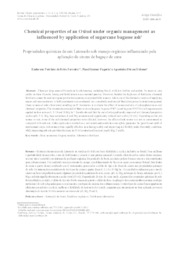Chemical properties of an Oxisol under organic management as influenced by application of sugarcane bagasse ash.
Chemical properties of an Oxisol under organic management as influenced by application of sugarcane bagasse ash.
Author(s): FERREIRA, E. P. de B.; FAGERIA, N. K.; DIDONET, A. D.
Summary: There are large areas of Oxisols in South America, including Brazil, with low fertility and acidity. To improve crop yields on these Oxisols, liming and fertilization is an essential practice. However, besides the high cost of fertilizers, chemical fertilizers cannot be used in organic production systems, except insoluble sources. Ash is one of the alternative source of supplying macro and micronutrients. A field experiment was conducted, in a completely randomized block design in a factorial arrangement (three sources of ash x four rates) resulting on 12 treatments, to evaluate the effect of source and rate of ash application on soil chemical properties. The treatments consisted of three sources (bagasse, bagasse+PJ07-A and bagasse+PJ07-RA) of sugarcane ash applied in four rates as 0; 5; 15 and 30 Mg ha-1. Results showed that the use of ash significantly improved soil chemical properties such as pH, P, K, Mg, base saturation, K and Mg saturation and significantly reduced soil acidity (H+Al). Depending on the ash source or rate, some of the soil chemical properties were affected, however, the effect of ash source was not so pronounced as compared with ash rate. Ashes application resulted on a soil nutritional condition enough to guarantee the growth and yield of most annual crops. Ash sources were equally effective in reducing acidity and improving soil fertility under this study condition, while increasing ash rate provides decrease in H+Al content and increase in pH, Mg, P and K.
Publication year: 2012
Types of publication: Journal article
Unit: Embrapa Rice & Beans
Keywords: Ash, Base saturation, Cinza, Fertilizante, Fertilizers, Resíduo orgânico, Saturação
Observation
Some of Embrapa's publications are published as ePub files. To read them, use or download one of the following free software options to your computer or mobile device. Android: Google Play Books; IOS: iBooks; Windows and Linux: Calibre.
Access other publications
Access the Agricultural Research Database (BDPA) to consult Embrapa's full library collection and records.
Visit Embrapa Bookstore to purchase books and other publications sold by Embrapa.

